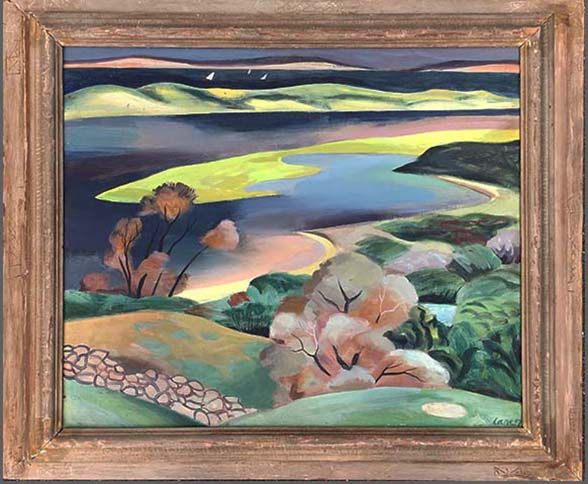

BETTY LANE
"LOW TIDE, MARTHA'S VINEYARD"
OIL ON PANEL, SIGNED, TITLED
AMERICAN, DATED 1947
20 X 24 INCHES

Betty Lane 1907-1996 Betty Lane was born in 1907, in Washington D.C., the youngest of six children and the daughter of a Marine Corps General. Betty was pretty and outgoing and received considerable attention. She was close to both her parents although her mother was said to be the one that molded her ambition and independence. Lane's artistic curiosity was established in childhood, with her first art class and the gift of a box of watercolors. At this time, she made her decision to become an artist although she was not sure how or what needed to be done. As an artist Betty was a prodigy. It could be said that Lane was both self-taught and professionally educated. A relative recalled she was not a good student and except for the actual doing of music and art, she got very little classroom education. Initially, she trained by copying Saturday Evening Post covers. After perfecting the art of replication Lane moved on to oil, although the medium frustrated her. She decided not to try again until art school. Directly after high school, Lane trained at the Corcoran School of Art, in Washington, D.C. She did not enjoy her education at the Corcoran and wished instead to study in Paris. However Lane acknowledged that her parents were financially pressed and transferred instead to Massachusetts Normal Art School (now Massachusetts College of Art). While there, she reviewed the various museums and galleries in Boston for the college magazine. Eventually, in 1928 at the age of 21, Lane traveled to Paris with her sister and studied under well-known cubist and colorist André Lhote. She received formal training in his studio tucked in behind the Gare Montparnasse where people were jockeying for space. After almost two years, Lane returned to the States. In Washington, she met millionaire art patron Duncan Phillips of the Phillips Memorial Gallery (now the Phillips Collection) who gave her a private exhibition. With the success of her show she was able to return to Europe. Later, to her delight, she was informed that master Henri Matisse had noticed her work at the Philips Gallery and demanded to know who had produced it. He grunted many “Oui, Oui's” and told the staff that it “pleased him very much." In England, Betty married Gerald Noxon, a Canadian writer and filmmaker. She stepped back from painting and in 1936, she gave birth to her son, Nicolas. In 1939, Hitler’s attack forced the new family to flee to rural Canada. There, alone and isolated much of the time, Betty began to focus again on her art. However, by the end of World War II, with the rise of the New York School of Abstract Expressionism, her earlier success was somewhat overshadowed. Betty continually struggled for independence with respect to what she wanted to do and where she wanted to settle. In 1950, after 20 years of marriage, she was divorced and settled on Cape Cod. She later began a teaching career at Miss Porter's School in Farmington, Connecticut. In time, she was able to travel throughout Europe, Latin America and Asia. She retired from teaching after 14 years and devoted the rest of her life to painting. Throughout Lane's artistic career, she kept numerous journals, which provide insight into her dedication to art and the ideas behind individual paintings. Lane continued to paint until her death in 1996. A major retrospective of her work was mounted the following year at the Cape Cod Museum of Art. Chronology
|